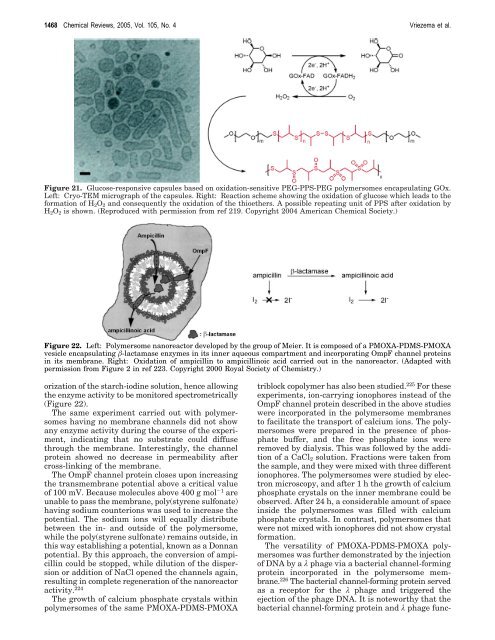Self-Assembled Nanoreactors - Cluster for Molecular Chemistry
Self-Assembled Nanoreactors - Cluster for Molecular Chemistry
Self-Assembled Nanoreactors - Cluster for Molecular Chemistry
Create successful ePaper yourself
Turn your PDF publications into a flip-book with our unique Google optimized e-Paper software.
1468 Chemical Reviews, 2005, Vol. 105, No. 4 Vriezema et al.<br />
Figure 21. Glucose-responsive capsules based on oxidation-sensitive PEG-PPS-PEG polymersomes encapsulating GOx.<br />
Left: Cryo-TEM micrograph of the capsules. Right: Reaction scheme showing the oxidation of glucose which leads to the<br />
<strong>for</strong>mation of H2O2 and consequently the oxidation of the thioethers. A possible repeating unit of PPS after oxidation by<br />
H2O2 is shown. (Reproduced with permission from ref 219. Copyright 2004 American Chemical Society.)<br />
Figure 22. Left: Polymersome nanoreactor developed by the group of Meier. It is composed of a PMOXA-PDMS-PMOXA<br />
vesicle encapsulating �-lactamase enzymes in its inner aqueous compartment and incorporating OmpF channel proteins<br />
in its membrane. Right: Oxidation of ampicillin to ampicillinoic acid carried out in the nanoreactor. (Adapted with<br />
permission from Figure 2 in ref 223. Copyright 2000 Royal Society of <strong>Chemistry</strong>.)<br />
orization of the starch-iodine solution, hence allowing<br />
the enzyme activity to be monitored spectrometrically<br />
(Figure 22).<br />
The same experiment carried out with polymersomes<br />
having no membrane channels did not show<br />
any enzyme activity during the course of the experiment,<br />
indicating that no substrate could diffuse<br />
through the membrane. Interestingly, the channel<br />
protein showed no decrease in permeability after<br />
cross-linking of the membrane.<br />
The OmpF channel protein closes upon increasing<br />
the transmembrane potential above a critical value<br />
of 100 mV. Because molecules above 400 g mol -1 are<br />
unable to pass the membrane, poly(styrene sulfonate)<br />
having sodium counterions was used to increase the<br />
potential. The sodium ions will equally distribute<br />
between the in- and outside of the polymersome,<br />
while the poly(styrene sulfonate) remains outside, in<br />
this way establishing a potential, known as a Donnan<br />
potential. By this approach, the conversion of ampicillin<br />
could be stopped, while dilution of the dispersion<br />
or addition of NaCl opened the channels again,<br />
resulting in complete regeneration of the nanoreactor<br />
activity. 224<br />
The growth of calcium phosphate crystals within<br />
polymersomes of the same PMOXA-PDMS-PMOXA<br />
triblock copolymer has also been studied. 225 For these<br />
experiments, ion-carrying ionophores instead of the<br />
OmpF channel protein described in the above studies<br />
were incorporated in the polymersome membranes<br />
to facilitate the transport of calcium ions. The polymersomes<br />
were prepared in the presence of phosphate<br />
buffer, and the free phosphate ions were<br />
removed by dialysis. This was followed by the addition<br />
of a CaCl2 solution. Fractions were taken from<br />
the sample, and they were mixed with three different<br />
ionophores. The polymersomes were studied by electron<br />
microscopy, and after 1 h the growth of calcium<br />
phosphate crystals on the inner membrane could be<br />
observed. After 24 h, a considerable amount of space<br />
inside the polymersomes was filled with calcium<br />
phosphate crystals. In contrast, polymersomes that<br />
were not mixed with ionophores did not show crystal<br />
<strong>for</strong>mation.<br />
The versatility of PMOXA-PDMS-PMOXA polymersomes<br />
was further demonstrated by the injection<br />
of DNA by a λ phage via a bacterial channel-<strong>for</strong>ming<br />
protein incorporated in the polymersome membrane.<br />
226 The bacterial channel-<strong>for</strong>ming protein served<br />
as a receptor <strong>for</strong> the λ phage and triggered the<br />
ejection of the phage DNA. It is noteworthy that the<br />
bacterial channel-<strong>for</strong>ming protein and λ phage func-

















